#Emancipation Sculpture
Explore tagged Tumblr posts
Text
#OTD in 1882 – Unveiling of O’Connell monument in Dublin.
One of Dublin’s finest sculptors, John Henry Foley designed this imposing and remarkably beautiful memorial to Daniel O’Connell which was unveiled at the south end of what was called Sackville street – the name was changed to O’Connell street in 1924 – to admiring crowds gathered in the pouring rain on 15 August 1882. In 1829, Daniel O’Connell, known as the ‘Liberator’, had achieved through…

View On WordPress
#1829 Act of Emancipation#Cahersiveen#Co. Kerry#Daniel O&039;Connell#Daniel O&039;Connell Monument#Dublin#John Henry Foley#Memorial#Monument#O&039;Connell Street#Sackville Street#Sculpture#The Emancipator#The Liberator
6 notes
·
View notes
Text










Juneteenth
The freedom of African Americans from slavery in the U.S. in 1865 is celebrated on the holiday Juneteenth on June 19. Juneteenth is made up of the words ‘June’ and ‘nineteenth,’ and it is on this day that Major General Gordon Granger arrived in Texas more than 155 years ago to inform slaves that slavery had been abolished.
The freedom of African Americans from slavery in the U.S. in 1865 is celebrated on the holiday Juneteenth on June 19. Juneteenth is made up of the words ‘June’ and ‘nineteenth,’ and it is on this day that Major General Gordon Granger arrived in Texas more than 155 years ago to inform slaves that slavery had been abolished.
When is Juneteenth 2024?
Juneteenth, which marks the end of slavery in the U.S. and commemorates African-American freedom, is observed on June 19.
History of Juneteenth
According to the official website of the historical event, Juneteenth is ‘the oldest nationally celebrated commemoration of the ending of slavery in the United States.’ Other than marking a pivotal date of significance in American history, Juneteenth also serves as an opportunity for African Americans to cherish their culture and heritage.
More than 155 years old, Juneteenth celebrates the liberation of African Americans from slavery in the U.S. The reason for it being celebrated on June 19 is because, on this day in 1865, when Major General Gordon Granger of the Union Army landed in Texas, he brought the news that the Civil War had ended and all slaves were free.
The proclamation declaring the abolishment of slavery was issued by President Abraham Lincoln on January 1, 1863, in the nation’s third year of an ongoing civil war. Known as the Emancipation Proclamation, it declared that ‘all persons held as slaves within any State or designated part of a State […] shall be then, thenceforward, and forever free.’ Granger’s arrival at Texas was to enforce this decree, which had originally gone into effect two years earlier.
The news had come as a shock to more than 250,000 slaves in Texas who were unaware of it.
On June 19, in the city of Galveston, Granger publicly read General Order No. 3, which stated: ‘The people of Texas are informed that, in accordance with a proclamation from the Executive of the United States, all slaves are free.’
As to why the news of the abolition of slavery reached Texas so late, there are varying accounts. One story states that the messenger bearing the news was assassinated on his journey. Some historians believe that the report on the Emancipation Proclamation was withheld by slave owners in Texas on purpose so that they can go about their business as usual and keep the labor force working. Historians also note that, until 1865, Texas remained a Confederate State, so Lincoln’s proclamation could not have been enforced until Robert E. Lee surrendered to the Union Army and they took over.
Either way, Granger’s arrival with the grand news stirred the air with jubilance and massive celebrations across the state. A former slave named Felix Haywood gave his recount of the first celebration in 1865 in the book “Lone Star Pasts: Memory and History in Texas” — ‘We was all walkin’ on golden clouds […] Everybody went wild […] We was free. Just like that, we was free.’
Juneteenth timeline
June 19, 1865 Texas Slaves Finally Gain Their Freedom
Even though they are officially made aware of the Emancipation Proclamation on this day, many slaves stay with their masters as paid hands.
August 28, 1963 ‘I Have a Dream’
Martin Luther King delivers one of history’s most inspirational speeches in front of roughly 200,000 people at the Lincoln Memorial.
July 2, 1964 President Johnson Signs the Civil Rights Act
This act gives the federal government the power to enforce desegregation while prohibiting discrimination based on race, color, religion, or national origin.
1980 Texas Declares Juneteenth a State Holiday
While Texas was the first state to observe Juneteenth as a state holiday, many others have since followed suit.
June 14, 2019 Call for a National Holiday
“Boston Globe” columnist Renée Graham writes that Juneteenth deserves an elevated status, noting that many African Americans regard the nation’s July 4 holiday with deep ambivalence.
Juneteenth FAQs
Why is Juneteenth called Juneteenth?
Juneteenth is a fusion of the words ‘June’ and ‘nineteenth.’ The emancipation of African Americans from slavery in the U.S. officially happened on June 19.
Is Juneteenth a national holiday?
The only three states yet to legally recognize Juneteenth as either a state or ceremonial holiday are Hawaii, North Dakota, and South Dakota.
What is Juneteenth and why is it important?
Juneteenth is an extremely important holiday in history, commemorating the day when the enslaved people of Texas learned that slavery had been abolished and that they are free.
How to Observe Juneteenth
Fly the Juneteenth flag
Attend a Juneteenth celebration
Watch a movie about slavery
Echoing the red, white, and blue of the U.S. flag, the Juneteenth flag signifies that slaves and their descendants are true Americans. A star in the middle represents Texas, with a larger outer star representing new freedom and a new people.
Some citizens in the southern states celebrate with readings and oral histories of their ancestors, which is an honorable way to remember a somber period in American history. Celebrations also include cookouts, rodeos, concerts, and parades.
Recent titles include "12 Years a Slave," "Glory," Amistad" and "Django Unchained."
5 Courageous Americans Who Fought For Equality
Dr. Martin Luther King, Jr.
Rosa Parks
Mildred Loving
Frederick Douglass
Dred Scott
Perhaps the most widely recognizable name associated with the civil rights movement, Dr. King gave us the famous "I have a Dream" speech in August 1963 — his 1968 murder proved that the movement still had a lot of work to do.
With a simple refusal to surrender her seat on a public bus, Parks made a bold statement for African Americans in the South — her December 1955 arrest inspired the Montgomery Bus Boycott.
Loving and her husband, Richard, were jailed for unlawful cohabitation in Virginia where interracial marriage was illegal in 1958 — their case reached the Supreme Court in 1967, which ruled unanimously in their favor.
An escaped slave, Douglass became an advocate for the abolition of slavery as well as women's rights.
Enslaved African American Dred Scott sued for his family's freedom in 1857 — the Supreme Court ruled against him, finding that no person of African ancestry could claim U.S. citizenship.
Source
#Breaking the Chains by Melvin Edwards#San Diego#Boston#Atlanta#USA#Emancipation Statue by Thomas Ball#Behold by Patrick Morelli#sculpture#Martin Luther King Jr. National Historic Site#original photography#cityscape#Martin Luther King Jr. Center for Nonviolent Social Change#Columbia#African-American History Monument by Ed Dwight#Juneteenth#19 June 1865#tourist attraction#landmark#travel#vacation#architecture#anniversary#US history
1 note
·
View note
Text
Freedom Monument Sculpture Park honors lives of enslaved people
For civil rights attorney and renowned social justice activist Bryan Stevenson, it’s not enough to know the history of slavery and the centuries-old struggles of Black people in America. He wants people to see it. Feel it. Touch it.
A new park in Montgomery, Alabama, was conceived to do just that, as visitors of the breathtaking Freedom Monument Sculpture Park will be treated to “an immersive experience” along 17 acres above the Alabama River, which was a primary route to transport enslaved Africans during the slave trade.
The park, opening next week, will be in close proximity to two other creations led by Stevenson: the awe-inspiring Memorial to Peace and Justice, an open-air site that features 800 columns suspended from above, evoking public square lynchings, and the Legacy Museum. A few miles away in downtown Montgomery, that site uses interactive elements to tell the story of the devastation of slavery, Jim Crow, violence and mass incarceration.
Located at 831 Walker Street, the Freedom Monument Sculpture Park will be part of the Equality Justice Institute’s Legacy Sites, which also include The Legacy Museum and The National Memorial for Peace and Justice, both which opened in 2018. A $5 admission includes all three parks and a free shuttle runs between the sites.
As the center of the Civil Rights Movement, Montgomery is also home to other Black heritage sites, like the Rosa Parks Museum, Civil Rights Memorial Center, Anarcha, Lucy, Betsey Monument, Dexter Avenue King Baptist Memorial Church, Freedom Rides Museum, and Dr. Richard Harris House.
Source: NBC News, Travel + Leisure
Visit www.attawellsummer.com/forthosebefore to learn more about Black history.
Need a freelance graphic designer or illustrator? Send me an email.
#Alabama#Montgomery Alabama#Freedom Monument Sculpture Park#The Legacy Museum#The National Memorial for Peace and Justice#Equal Justice Initiative#Bryan Stevenson#National Monument to Freedom#enslaved people#slavery#emancipation#Emancipation Proclamation#memorial#Black history#Alabama history#Alabama River
1 note
·
View note
Text
Finally I'm able share some good news
Wild festivals, exquisite fruit-bowls and unusually realistic renderings of motherhood and female friendship – not to mention a glimpse of Lady Hamilton as an enthusiastic follower of Bacchus – will go on show in Madrid on Tuesday as one of the country’s most famous galleries seeks to spike the patriarchal canon of art history with a new, and avowedly feminist, exhibition.
The show at the Thyssen-Bornemisza – called simply Maestras (Women Masters) – uses almost 100 paintings, lithographs and sculptures to show how female artists from the late 16th to the early 20th centuries won recognition in their own lifetimes, only to find their works forgotten, erased or consigned to dusty storerooms.
Organised into eight chronological sections that reflect artistic and social changes, Maestras also explores how female artists, gallerists and patrons worked together to create and celebrate art while living and working in the grip and gaze of sexist, and often misogynistic, societies.
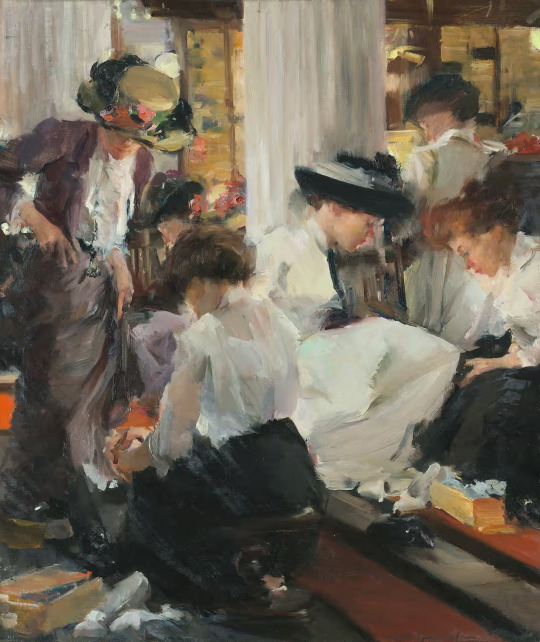
Elizabeth Sparhawk-Jones, The Shoe Shop, 1911. Photograph: Elyse Allen/© Art Resource, New York Scala, Florence
Seventeenth-century works by Artemisia Gentileschi, Fede Galizia and Elisabetta Sirani give way to still lifes of fruit and flowers before the exhibition moves to portraits – including Élisabeth Louise Vigeé Le Brun’s Lady Hamilton as a Bacchante – and then to Orientalism, depictions of working women, images of maternity, sisterhood and, finally, to images of female emancipation.
Among the show’s early exhibits is one of Gentileschi’s anguished studies of Susanna and the Elders, while the later pieces include Mary Cassatt’s bleary-eyed Breakfast in Bed and Maruja Mallo’s playful Fair pictures.
“This exhibition speaks positively of that other half of art history,” said the exhibition’s curator, the art historian and critic Rocío de la Villa.
“For a long time, the feminist history of art has been beset by all the handicaps and obstacles that had been put in the path of female creators. For example, they couldn’t access the same artistic training that their male colleagues could. They generally lived in an extremely patriarchal system that denied them their rights and in which their signatures had no legal value.”
There were, however, “certain moments and certain places” in which conditions were more favourable to female artists, and the show aims to offer “a series of windows through which we can see a mutual understanding and a camaraderie between artists, gallery owners and patrons”.
It also reminds visitors that some talented women caught the eye of European royal courts, and that some had husbands who helped them in the studio – or even looked after their children – because they knew that their wives’ gifts far exceeded their own.
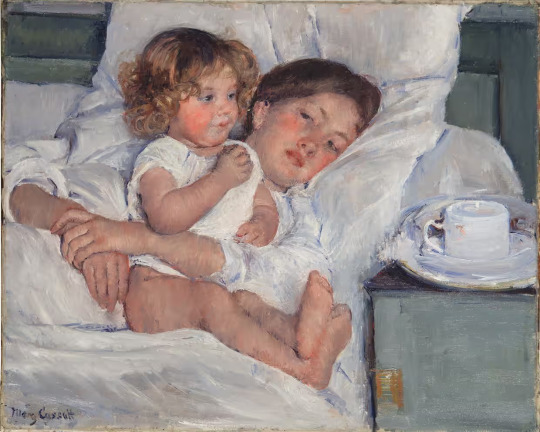
Mary Cassatt, Breakfast in Bed, 1897. Photograph: The Huntington Library, Art Museum
Guillermo Solana, the artistic director of the Thyssen-Bornemisza, said Maestras was another example of the museum’s continuing commitment to feminism, education and addressing the prejudices of the past.
“I’d promised myself that I wouldn’t do any mansplaining today but I can’t help it when it comes to explaining what I’ve learned from the process of doing this exhibition, because I’ve learned a lot,” he told journalists on Monday morning.
“The first thing I learned from this exhibition – and which I think the public will also learn – was so many new names; so many fantastic artists I’d had no idea about and had never heard of. Of course, we knew about Artemisia Gentileschi and Frida Kahlo or Paula Modersohn-Becker, but how many important artists have got away – or been taken from us?”
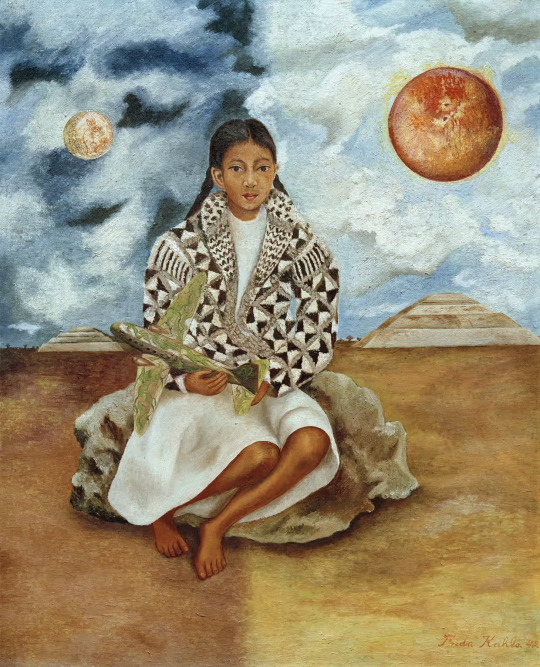
Frida Kahlo, Portrait of Lucha María, A Girl from Tehuacán, 1942. Photograph: akg-images/© Rafael Doniz @ 2023 Banco de México Diego Rivera Frida Kahlo Museums Trust, México, D.F./VEGAP
De la Villa agreed. “The public is going to ask, ‘How can it be that we didn’t know about these female artists?’” she said.
“How is it that their works were in storerooms until recently? Maestras is a feminist exhibition that seeks to emphatically correct the prejudices that have come about as a result of the patriarchy – prejudices that have meant that works by female artists have remained in museum storerooms during the 20th century.”
She said the male-dominated artistic system had always sought to defend itself by denigrating female artists. Equally damaging, she added, was how historians had played down the achievements of women until their voices were silenced and their creations overlooked and then hidden from view.
“When women are hidden, or robbed of their past, they are robbed of their identity,” said De la Villa. “The power of culture is very important. It just can’t be separated from the social conditions we enjoy, or which we suffer.”
Maestras is at the Thyssen-Bornemisza museum from 31 October to 4 February 2024
#Spain#Madrid#the Thyssen-Bornemisza#Maestras (Women Masters)#Elizabeth Sparhawk-Jones#mary cassatt#frida kahlo#October 31st to February 4th 2024
112 notes
·
View notes
Text

Nataraja ॐ
The symbolism of Nataraja, the Cosmic Dancer
The Cosmic Dancer The cosmic dance is the dance of life itself, including creation, preservation, destruction of the entire universe and spiritual grace to understand and go beyond to liberation.
In Hinduism, the objective of life is not to go to heaven but to attain liberation, which means to understand the true nature of ourselves beyond the ego-person that we are familiar with.
I have always wondered why dance was chosen as the art to represent this, not music, painting, poetry, sculpture or any other art. In my view, it may be because dance is the only art that cannot stand by itself without the artist.
One can observe and enjoy paintings, sculptures, poetry and even listen to music, but there is no dance without the dancer being present and visible in the moment. It is a powerful way of showing God is immanent in all of creation. The creator and creation are inseparable.
Ring of Fire
Shiva’s dance is set within a ring of cosmic fire, prabha mandala, which represents time (which destroys everything) and which is shown as a circle to symbolize the Hindu belief that time is cyclical and without end.
Within the cosmos represented by the ring of fire, the form of Nataraja is seen as comprised of five concepts:
Srishti, creation, evolution Sthiti, preservation, support Samhara, destruction, evolution Tirobhava, illusion Anugraha, release, emancipation, grace
Srishti His upper right hand holds a small hourglass shaped drum (damaru) that makes the primal sounds of creation Shrishti.
There is this interesting idea in Hinduism that creation originates as sound, as vibration. Fritjof Capra found echoes of quantum theory in this, where all matter is vibrating at the atomic level.
Here are a couple of extracts from Fritjof Capra’s The Tao of Physics:
“The Dance of Shiva symbolizes the basis of all existence. At the same time, Shiva reminds us that the manifold forms in the world are not fundamental, but illusory and ever-changing. Modern physics has shown that the rhythm of creation and destruction is not only manifest in the turn of the seasons and in the birth and death of all living creatures, but is also the very essence of inorganic matter.
“According to quantum field theory, the dance of creation and destruction is the basis of the very existence of matter. Modern physics has thus revealed that every subatomic particle not only performs an energy dance, but also is an energy dance; a pulsating process of creation and destruction. For the modern physicists then, Shiva’s dance is the dance of subatomic matter, the basis of all existence and of all natural phenomena.”
In recognition of this profound and seamless bridging of mythology, religion, science and the ever-changing universe, a large bronze Nataraja stands at CERN, Switzerland, home to the Large Hadron Collider and the main home of modern research into particle physics.
Sthiti His lower right hand makes the abhaya mudra. It is the gesture of fearlessness or protection for his devotees. It also indicates preservation/support for the cosmos
Samhara His upper left hand holds a blazing flame or agni, symbolizing his power of destruction.
The way both creation and destruction are held in the dance pose signifies the balance between the two.
There is another interesting aspect of balance as well, that’s not often discussed.
Nataraja has different earrings in each ear. On the right ear is an earring in the shape of a crocodile, usually worn by men. His left ear has a traditional circular earring worn by women. The divine can be seen as male, female, both, and neither, another facet of Hinduism.
Tirobhava His right foot is on a dwarf, personifying human ego, ignorance and spiritual illusion which he keeps under control. This is the act of tirobhava or veiling — that is, reality is veiled from our understanding.
The serpent around his neck represents both our evil tendencies but also the coiled kundalini shakti within us (those interested in yoga would likely have come across the term kundalini).
Anugraha Anugraha, grace and emancipation, is indicated by the combination of the lower left hand, which points toward his upraised foot, showing the way to moksha in surrendering to the lord.
The uplifted left leg is revealing grace, which releases the mature soul from bondage. Hindus touching the feet of their elders in respect is an echo of God’s feet being considered holy.
37 notes
·
View notes
Text
Relations between Babeuf and Robespierre


Babeuf had a rather complex opinion of Robespierre (worship then hate then worship). In fact, this dates back well before the French Revolution. Through Dubois, Babeuf praises Robespierre. After all, Babeuf already had strong views about the Revolution. Here’s what he says about Robespierre: “He knows, as we do, that most of the time, bastards are the children of poor girls and ‘young men,’ sons of families whose parents would disinherit them if they had the misfortune of marrying beneath them, to avoid committing an outrage, to avoid sullying themselves with a crime. He knows, as we do, that the great factory of bastards is in the convents, and that among both sexes, the vow of celibacy is not a vow of chastity... I sense that he is a man of exact integrity and rare selflessness.”
When Robespierre delivered his famous speech in response to Louise de Kéralio’s remarks, saying: "It must be admitted: the admission of a woman into a literary society was regarded until now as a kind of phenomenon. France and all of Europe offered very few examples of it. The power of habit and perhaps the strength of prejudice seemed to oppose these two obstacles to the wishes of those who might aspire to take their place among you. Two charming and learned women deigned to address you this year, and you did not hesitate for a moment to grant their request. Their sex did not cause them to lose any of the rights their merit gave them. What do I say? Their sex probably seemed to you an additional merit. (…) Would I have to fight those who, wishing to condemn all women to ignorance and frivolity, would regard as scandalous anything that would suggest in them a particular taste for useful knowledge? I will certainly avoid reopening this great question, which would itself be the scandal of an enlightened century."
Babeuf, in turn, would take up the pen (he was more committed to women's rights than Robespierre, but less so than Charles Gilbert-Romme and Condorcet, although Babeuf used sexist terms against Theresia Tallien) to go further than Robespierre: "The woman would not have taken refuge in these sad imitations if her genius had not been killed; there would then have been a literature of women, a poetry of women, music, painting, sculpture by women; alongside and equal to the genius of men, the genius of women would have risen with its own character, and the two sexes would have admired and charmed each other mutually. How much happiness and joy we would have gained from this!"
"True civilization halts and majestically sets a level, there lies the end of all misery, all groaning, all sobbing, all gnashing of teeth. Only there, when everyone is reassured about their fate, is the goal of society realized, for unless it is a league hostile to the principles of justice, it must be instituted solely for the purpose that the weak is no more unfortunate than the strong, the woman no more unfortunate than the husband, the mother than the father, the children than the father and mother, the sisters than the brothers, the younger than the older; the happiness of individuals, families, peoples, and sexes can only be a result of equalization: equalization perfects and destroys nothing but that which destroys. Sooner or later, it will destroy the servitude of women; it will proclaim their emancipation. What would be the consequences of this emancipation, what new laws would be indispensable for it to have only salutary effects? These are questions I am not in a position to answer, but one day we must consider them."
In 1791, Babeuf held admiration for Robespierre, Pétion, Abbé Grégoire, Buzot, and people like Chapelier, Malouet. He said to Robespierre, "Analyze Robespierre, you will find him also agrarian in the final result, and these illustrious figures are obliged to maneuver because they feel that the time has not yet come," Babeuf would assert to Abbé Coupé in a letter on September 10, 1791.
Even though Babeuf’s social ideas went much further than Robespierre’s, he still held great admiration for him. Here’s what he wrote to his wife in May 1793: "I have here as friends the most distinguished people in Paris: Chaumette, procurer of the Commune, Pache, mayor, Garin, municipal officer and general administrator of supplies, Robespierre, Sylvain Maréchal, editor of Les Révolutions de Paris, and many others. All these people give me the warmest welcome despite my shabby attire."
We know that during this period, Babeuf would say of Robespierre: "But you, Robespierre, who have precisely defined property, who have outlined the boundaries within which this right must be confined to prevent it from being harmful to the great majority of society... Come, you are our legislator. And you, Jacobins! [...] come stand beside our Lycurgus..."
However, his opinion changes as we see in Thermidor. Is it because Robespierre never followed deeper social policies, like the fact that he wasn’t in favor of the maximum but had to accept it under pressure from the Hébertists (where the Enragés, the Hébertists, and part of the Babouvists supported this maximum)? Regarding the sharing of property rights, which he refused (like the vast majority of revolutionaries, including the Enragés or the Exagérés, with the exception of people like Momoro, etc.)? It is true that Robespierre was conservative in some aspects (particularly on women’s rights, on taxes, whereas Babeuf went further)? Or is it the fall and execution of certain people that Babeuf esteemed, such as Chaumette (where Babeuf, despite his modest needs, would do what he could to support the widow Chaumette, considered the widow of a traitor to the country)? Babeuf had criticized, even before Robespierre’s fall, the question of religious reason. On the other hand, Victor Daline states that there is no evidence that he was close to the cult of reason with the Hébertists (even though he shared some of their ideals) because in Histoire nouvelle de la vie de Jésus-Christ, he told Hébert: “Jean-Jacques, Père Duchesne, citizen Gillet, I do not fear giving you a formal denial. Jesus was neither more than a man, nor sans-culotte, nor a true Jacobin.” Even though he said of Robespierre, “Robespierre provoked an invitation for silence to all French people on matters of religion. This measure seemed necessary, and I do not intend to contradict it; its purpose was to suppress a vast fire of fanaticism, some sparks of which had already lit up and threatened to ignite the entire Republic.” He adds, “Certainly, the goal may be achieved by this measure, for it is impossible for something that is not discussed to cause fermentation. But one must rely on the possibility of general deference to the recommended silence. And would this goal be enough for us? Should we be content with precautions to prevent the monster of fanaticism from doing us harm? A kind of transaction with it, a clause allowing it to retain a semblance of existence within us, would it not warn us that we still recognize its power? We have done too much, it seems to me, against superstition to remain halfway; there is force in retreating or advancing.”
Here is what he says about Robespierre after Thermidor. Babeuf called Robespierre the “most cruel enemy of liberty” and said, “There were two people, that is, Robespierre, sincerely a patriot and a friend of principles until the beginning of 1793, and Robespierre, ambitious, a tyrant, and the deepest villain since that time; this Robespierre, I say, when he was a citizen, is perhaps the best source from which to seek the great truths and strong proofs of the rights of the press. It is with the weapons he left that I will begin the battle of sophisms against the reasoners of the day.” (Babeuf, Journal de la liberté de la presse, N°1, p. 3 and 4, September 1794).
In fact, it seems that Babeuf was one of the first to use the word "terrorist" for the revolutionary excesses: "Patriot terrorists (the French love variety, this expression will soon come into fashion).” But Babeuf, at the same time, attacked other members of the Committee of Public Safety, like Barère, saying that Robespierre was not the only one. “Today, patriots who dare preach the rights of man are not off the hook so easily. First, they are chased from the Jacobins, then imprisoned, and then assassinated. But let us not say to Barère, Billaud, Bourdon, Collot, Carrier, Louchet, that chasing, imprisoning, and assassinating is not the answer. No matter how much you imprison, assassinate patriots, you will not kill the truth: it will come to light through the grates of your new bastilles…” (Babeuf, Journal de la liberté... op. cit., N°12, De la fête de l'Opinion, fourth sans-culotte, Year 2). So he does not fall into the ease of blaming just one man. Furthermore, he calls Collot d’Herbois, for what he did in Lyon, “a scourge of mankind, a monster of evil like Carrier, like Lebon.” It should be noted that at that time, Babeuf was unknowingly surrounded by people trying to blame Robespierre to cover up their own crimes, starting with Fouché, who exploited Babeuf’s humanist values, as I discussed here about the Fouché-Babeuf relationship and their ruptures here. And how strangely Turreau (one of the authors of atrocities in Vendée) adopted the son of Gracchus Babeuf, Camille Babeuf, after his father’s execution (the only good deed I found from him), while Gracchus Babeuf was fighting against the atrocities in Vendée with sincerity. However, he was definitely not a friend of the Muscadins or the jeunesse dorée, nor was he an anti-Jacobin; he always maintained his socially committed ideals, contrary to what some sources claim.
Yet, he would later reconnect with Robespierre posthumously and had close ties with the Duplay family. Babeuf even thought that Hébertism was a minority in the revolution. Here’s what he wrote to his Babouvist colleague, who was also an Hébertist and anti-Robespierre, Joseph Bodson, in February 1796: “I confess today, honestly, that I regret having once seen in black both the revolutionary government and Robespierre, Saint-Just, etc. I believe that these men were better than all the revolutionaries combined, and that their dictatorial government was devilishly well-imagined... I do not agree at all with you that they committed great crimes and caused the death of many republicans. Not so much, I believe. It was the Thermidorian reaction that caused many to perish. I do not enter into whether Hébert and Chaumette were innocent. If they were, I still justify Robespierre... Draftsmen, half-hearted men, hungry for glory and full of presumption, such as Chaumette, may have been seen by our Robespierre as wanting to challenge his leadership. So the one who had the initiative... must have seen that all these ridiculous rivals, even with good intentions, would hinder and ruin everything. I suppose he would have said: Let’s extinguish these annoying imps and their good intentions. My opinion is that he did well. The salvation of 25 million people must not be balanced against the deference to some ambiguous individuals... Rogues, fools, or presumptuous and ambitious for glory, it doesn’t matter, tough luck for them. Why are they in this? Robespierre knew all this, and that’s partly why I admire him. That’s what makes me see in him the genius where true regenerative ideas resided.” He says that a revolutionary cannot remain an Hébertist. He resumed his admiration for Robespierre. Nevertheless, one could argue that it is a pity he approved of the execution of Chaumette and even Hébert, stemming from a parody of justice (even more so Chaumette, who, despite his flaws, was a complex character and an effective prosecutor of the Commune as you can see here https://www.tumblr.com/nesiacha/753092098599829504/pierre-gaspard-chaumette?source=share , but on the other hand, Babeuf, while adoring Marat, as you can see here, did not hesitate to make harsh criticisms of him; for Babeuf, friendship did not exclude severity, so it is also possible he did the same with Chaumette and the hebertists ). He went from one extreme, criticizing the entire Committee of Public Safety, to another, saying they made few mistakes overall, whereas the truth lies somewhere in between, even regarding Robespierre.
An interesting fact among the Hébertist anti-Robespierre Babouvists, there was not only Joseph Bodson (who resented Robespierre for what he did to the Hébertists, if I understand correctly), close to Babeuf, and they held each other in high esteem, with Bodson being one of Babeuf’s "lieutenants," but also Clémence and Marchand, former members of the Paris Commune, whom the Committees of Public Safety and General Security had sent on mission to the departments of Oise and Seine-et-Oise in Year II, who were imprisoned before the 9th of Thermidor, along with General Fyon and Clerex. They played an important role in Babouvism.
I’m not sure about including Rossignol (Momoro’s friend and considered close to Ronsin and Vincent) because for a time, Robespierre defended him, but later abandoned him due to doubts about his connections with Ronsin and Vincent.
Buonarroti further developed Babeuf's thinking, who had now reconnected with Robespierre's ideas concerning the Hébertists.
“Hébert and Danton gave their names to two factions which, although both were enemies of the revolutionary government they had helped establish, differed fundamentally in their objectives and the character of the individuals they consisted of. Generally, the Hébertists were made up of hardworking, honest, straightforward, courageous men, who were not very studious, unfamiliar with political theories, who loved liberty for its own sake, enthusiastic about equality and impatient to enjoy it. They were good citizens in a settled popular republic but poor leaders in the storms preceding its establishment. It was not difficult to stir them against the prolongation of the revolutionary institution, by portraying it as a wrongful attack on the sovereignty of the people. It was also not hard to persuade them that in order to forever extinguish the source of superstitions and the power of the priests, all religious ideas should be banned. However, such men, more inclined to resolve difficulties through quick action than to carefully weigh the utility and consequences of a political crisis, had the same goal as the wise friends of equality, but they did not form a clear idea, like them, of the institutions through which it could be achieved, nor of the path to get there. Therefore, the blame for the disastrous division and misfortunes caused by the faction to which they belonged should not rest with them. A grave responsibility lies entirely with the influential men who, in the name of the public good, inspired unjust suspicions in them, and whose criminal blindness we regret not being able to excuse.”
Thus, Buonarroti, in some ways, aligns with Babeuf's thinking and, at other times, contradicts it. In reality, the Hébertists were more competent and more important to the revolution than popular culture often acknowledges (although they also had their share of faults and responsibilities). Moreover, Babeuf, in a piece addressed to Bodson, even though he speaks harshly of Chaumette, a man whose widow he supported, acknowledges Chaumette's good intentions.
What can we conclude? Surely, at times, Babeuf viewed things too black and white, given the horrible trials he had endured, and his enthusiasm sometimes led him to be careless. Had he lived longer, I believe he might have placed Chaumette on a pedestal alongside Robespierre, but that is just my opinion. Just as he initially placed Robespierre on a pedestal, then accused him of tyranny before rehabilitating him. However, Babeuf had brilliant ideas, economic plans at times, and was no fool. He was a humanist who managed to establish many important contacts across different political factions, such as Albertine Marat, who gave him a letter to publish against Fréron and subscribed to Le Tribun du peuple (she admired Danton and disliked Robespierre), Lindet (who, however, was not part of the conspiracy), as well as both Robespierre's supporters and the Hébertists. This is a significant quality.
I also think he was capable of forgiveness and understanding, provided that the person who committed the reprehensible acts did so with the intention of saving the revolution or France, and not out of a desire for corruption (even if it is only a theory). Example? During his last trial, Carnot was the one who harshly led the repression of the Babouvist movement, while Barras was more passive. Yet, during his trial, Babeuf only expressed a few criticisms of Carnot, even though he knew Carnot's role in leading him to his death, as you can see here. The theory, therefore, should be approached with caution: despite knowing what Carnot had done against him, Babeuf often criticized people like Fréron, Tallien, Fouché, and Barras. However, he recognized that, for all his flaws, Carnot was more sincere than they were in safeguarding the Republic. Or perhaps he simply never forgave Barras for feasting on corruption while Babeuf’s daughter slowly died from malnutrition.
But regardless of the revolutionary factions, our opinions on them—these were not monsters (I exclude the turncoats like Fréron, Barras, Tallien, Fouché, Turreau, and people like Carrier)—but rather complex men caught in a complicated period, as I have already said.
Even though I am quite (even very) critical of Robespierre, I leave this quote from Babeuf to conclude this article: "Maximilien Robespierre... this man whom the centuries will appreciate, and whose judgment it is for my free voice to anticipate."
P.S. If you're interested, here is Babeuf’s opinion on Abbé Grégoire: "Regarding what he calls vandalism," he says, “How old is he? Give him a decent pension and let him be quiet.” This is off-topic, but it might interest you.
Sources:
https://www.jstor.org/stable/41921463?read-now=1&seq=1#page_scan_tab_contents
https://www.jstor.org/stable/41925466
19 notes
·
View notes
Text

Art Nouveau, Bathhouses, and Winter Gardens Art, Body, and the Beginnings of LGBTQ+ Liberalization The Art Nouveau movement, also known as Jugendstil, developed between 1890 and 1910 as a reaction to industrial materialism and the often strict, puritanical morality of the Victorian era. Art Nouveau celebrated nature, the aesthetics of the human body, as well as the expression of emotions and individuality through organic forms, flowing lines, and floral motifs. This movement, which manifested in architecture, design, painting, and sculpture, played a crucial role in questioning and dissolving outdated societal norms. Although Art Nouveau as an independent art movement ended in the 1920s, its stylistic elements and ideas continued to influence architecture and design in the decades that followed.
The Victorian era (1837-1901) was characterized by strict morality, rigid gender roles, and a conservative view of sexuality. The body was often regarded as something shameful, and sexual openness or the recognition of LGBTQ+ relationships were socially taboo and even criminalized. Art Nouveau broke with these restrictive norms. The movement emphasized the beauty and sensuality of the human body without moral judgment. Artists such as Gustav Klimt, Aubrey Beardsley, and Alfons Mucha created works that celebrated sexuality, intimacy, and the human body in ways far removed from Victorian prudery. This opened up new ways of thinking about the body, sensuality, and human connections.
In parallel with the Art Nouveau movement, luxurious bathhouses and winter gardens emerged across Europe. These spaces not only served as places for relaxation and retreat from hectic urban life but also became symbols of the interplay between nature, the body, and art. Art Nouveau bathhouses were exquisitely designed, often lavishly decorated venues where architecture, art, and the human body harmoniously merged.
Winter gardens, originally found in the homes of the wealthy upper class, were often glass oases where nature was artfully integrated into urban spaces. These spaces offered refuge from the outside world and became places of self-discovery, contemplation, and sometimes expressions of non-conforming sexual orientations.
In this era, bathhouses and similar venues often existed on the fringes of societal norms and began to take on special significance for the emerging LGBTQ+ subculture. Bathhouses, particularly in major cities like Paris, Berlin, and Vienna, became meeting places for people who sought to explore their sexual orientation in a time when homosexuality was often still suppressed or criminalized.
Bathing itself, long symbolically associated with purity and cleansing, transformed in the context of Art Nouveau into a symbol of liberation from restrictive norms. The corporeality openly displayed in these spaces provided LGBTQ+ individuals with an opportunity to meet outside the rigid societal rules and explore their identity.
The Art Nouveau movement and its associated new openness toward the body and sensuality offered artists and intellectuals a platform to advocate for the rights of individuals who deviated from the conservative norms of the time. Writers like Oscar Wilde and Magnus Hirschfeld fought for the decriminalization of homosexuality and laid the groundwork for the later liberation movements of the LGBTQ+ community.
The Art Nouveau era marked a turning point in Western culture and society. It was not only a celebration of art and nature but also an era of upheaval and emancipation from strict moral norms. Bathhouses and winter gardens became places of retreat, freedom, and intimacy, especially for those who did not fit into the rigid corset of Victorian society. The Art Nouveau movement and its associated aesthetics paved the way for new perspectives on the human body, sexuality, and the acceptance of LGBTQ+ individuals in a society that was slowly but steadily changing.
Text supported by GPT-4o and Claude 3.5 Sonnet
Image generated with SD1.5. Overworked with inpainting (SD1.5/SDXL) and composing.
#ArtNouveau#Jugendstil#LGBTQHistory#QueerArt#VictorianEra#Bathhouses#WinterGardens#BodyPositivity#LGBT#Liberation#QueerCulture#gayart#queer
18 notes
·
View notes
Text

in the interest of negative criticism. I don't like this sculpture. edmonia was remarkably interesting and extremely skilled but the assertation of emancipated black men being granted their male freedom while "freed" black women (note that shes forced to straighten her hair to be hyperfeminized) could only exist between black patriarchal bondage or chattel slavery. one masters house to the next. its so bleak and depressing that marriage was considered the highest mode of black female liberation
3 notes
·
View notes
Text

Artis Lane (born Artis Shreve, in 1927) is a Black Canadian sculptor and painter. Her bronze bust of Sojourner Truth is on display in Emancipation Hall at the Capitol Visitor Center in Washington, D.C. It was unveiled in 2009, and was the first statue in the Capitol to represent an African-American woman. Lane's sculpture of Rosa Parks is on display in the Oval Office. via Wikipedia, photo: Lane at the unveiling of her bust of Sojourner Truth at the U.S. Capitol

Bust of Sojourner Truth (2009)
2 notes
·
View notes
Text
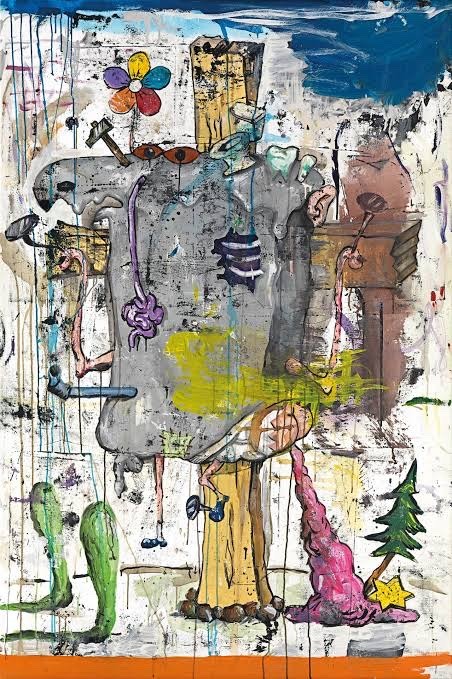
1. A painting for a proposed sculpture
2.

1. A Painting for a Proposed Sculpture
2. ILLUSTRATOR
Manuel Ocampo is an artist whose work, both stylistically and thematically, has inspired my process as of late.
Best known for his Catholic Grand Guignol imagery, Ocampo once claimed to have learned his signature faux retablo style from a priest for counterfeiting purposes. Largely self-taught, he dazzled the art world with his precocity and virtuosity, leaping from a single one man show in Los Angeles in 1988 to rave reviews and participation at the Documenta and Venice and Whitney Biennials. Among his provocative subjects are ancient forms of crosses, including the swastika, a symbol that caused his expulsion from the main floor and relegation to the basement at Documenta IX in Kassel, Germany in 1992.
Ocampo’s surreal imagery begs explanation; he layers Spanish religious icons, American pop culture, local kitsch and obscure texts to illustrate Filipino post-colonial identity.
On his compositional style: “This is where I live. It’s a mess, which is why my paintings are a mess,” he claimed, starting the slide show with an aerial view of a massive Manila traffic jam, vehicles and people gridlocked in anarchy.
On his provocative subject matter: “I’m not afraid of controversy—in fact, I invite it,” he admitted, in response to a question on his intentions. “I’m saying, look at this, but don’t look at it, it’s just a painting, it is not real” —reminding the audience that his paintings are mere two-dimensional explorations, and no gods were actually harmed in the making of his art.
On his choice of medium. “I’ve always been a painter, it’s always been about how I can push painting further. I might ask people to pay attention to the pieces in ways other than conventional painting, but in the end I’m expanding the concept of what a painting is.” Ocampo was referring to his forays into installation, such as at a Los Angeles show where he stripped his paintings from their frames and laid them on the floor to be walked on, hanging one as a hammock.
On sources of inspiration. He credits his first job drawing editorial cartoons for his mother’s newsletter with his love of incorporating text in his works. He finds material literally everywhere. A postcard with the cryptic text, “comprehensive only to a few initiates,” found on the floor, was appropriated in full for a text-only painting (2000-2001). Another text that sparked a work was conceptualist John Baldessari’s quote, “Everything is purged from this painting but art, no ideas have entered this work,” which he inscribed around a Duchampian toilet, overturned and spilling intestines, in his work, Artist Examining Life Closely (1998). The work currently on exhibit, An Object at the Limits of Language—Necromantic Kippian Emancipator: No. 2 was painted in response to the death of German artist Martin Kippenberger, whose absurdist humour Ocampo greatly admires.
3 notes
·
View notes
Text
DCist: Art Installation Calls Out Community Erasure, Past And Present

In what is now known as Metropolitan Park — created in phase one of Amazon’s headquarters in Arlington — a red brick tower stands resolute, reminding passersby that nearly a century ago a community was erased nearby.
The simple structure, which stands 35 feet tall in an area filled with high-rises and office buildings, seems lost in time. Its red brick exterior evokes a long-past, industrial era — one similar, maybe, to the era East Arlington residents lived in.

When visitors step inside the sculpture, they’re greeted by 903 ceramic teardrop-shaped “vessels” — one for every displaced community member.
The space is quiet, intimate and — above all — inspiring. According to Durrett, who spoke in an interview with Street Sense Media, that’s exactly the point.
“I try to leave space for the viewer to experience awe,” Durrett said. “First you see this mundane brick structure that looks like it’s from some bygone period. And then you enter the space and you’re met with something completely unexpected. The viewer then has all of these questions, and then hopefully feels inspired to find the answers and then learn this history that so many people don’t know.”
That history is a tragic one. East Arlington was a victim of displacement long before the 1940s, according to a 2011 presentation by the Arlington Public Library. Many of its residents previously lived in Freedman’s Village, a post-emancipation attempt to house enslaved people, before they were forced out by the government — this time to build the Arlington National Cemetery.
The construction of the Pentagon, at the time the largest office building in the world, initially offered a welcome source of work for men in Queen City, according to Dr. Nancy Perry’s 2014 lecture at the Arlington Historical Society.
East Arlington residents worked on the construction of the Pentagon for months before they were informed that the project would unseat them from their home, Perry said. The Black Heritage Museum of Arlington notes that Queen City was specifically displaced for construction of the transportation corridor that would ferry commuters to the Pentagon.
Without the means to move their belongings, many families were forced to leave behind almost everything they owned, according to the lecture. They fled — first to different temporary housing sites, and then to different parts of the country. Many of them never saw their neighbors again.
It was that side of the tragedy — the human suffering — that the artist said she wanted to evoke. In addition to researching the historic community, Durrett arranged a meeting with one of its last living residents. Her conversation with 92-year-old William Vollin, she said, taught her more about Queen City than archives ever could.
“Being able to identify and speak with someone who has been carrying that history since they were 12 years old further humanized the experiences that those people would have gone through,” Durrett said. “When I was speaking to [Vollin], he didn’t recount losing his home or any material possessions. What he did speak about was the loss of his community. About how he never saw most of those people ever again. He speaks about the destruction of Queen City as though it just happened yesterday.”
But the sculpture is about more than a single community, Durrett said. According to data from the housing search site Apartment List, D.C.’s cost of living is 53% higher than the national average — one of the least affordable cities in the nation.
“Queen City” tells a story of Black displacement at a time when, according to analysis by the Urban Institute, the District’s Black population has been declining for decades. The sculpture, according to Durrett, teaches more than just history.
“The value of learning that history is connecting the dots, it’s seeing how this sort of erasure persists into the present day.”

To create the 903 teardrops that line the interior of “Queen City,” each representing a displaced resident, Durrett commissioned 17 Black ceramicists from across the country.
“One thing that I asked them,” said Durrett, “was to bring forward stories of a Queen City in their own community. Each and every one of them had one.”
Although the artists might have been aware of each other’s work, this was their first opportunity to work together, Durrett said. Each ceramicist had varying abilities and experience, especially with the teardrop-shaped vessels Durrett was requesting.
This led to a “beautiful thing” happening, Durrett said. The ceramicists, rather than working independently on their portion of the commission, collaborated. Artists with more expertise met with less confident ones, creating an atmosphere of compassion and partnership.
In the process of memorializing a community, Durrett said, they had become one themselves.
“Using community, the very thing that was destroyed when East Arlington was razed, to actually create something as grand and long-lasting as ‘Queen City,’ was beautiful,” Durrett said. “It’s not just about the thing, the object — it’s about the process of making it. It’s about showing what we’re all capable of when we work together.”
#Freedmens Village#Queen City#Arlington#Black Cities raised for nothing#pentagon#Black Lives Matter#real estate fuckery#american lies#american hate#white supremacy#imminent domain#East Arlington VA#Black Communities#Black History in america#american history
3 notes
·
View notes
Text
Adélaïde Labille-Guiard: Artist in the Age of Revolution by Laura Auricchio. Adélaïde Labille-Guiard (1749-1803) was one of the few women artists granted membership in the French Royal Academy of Painting and Sculpture, and the examples of her exquisite portraits in this book show why. But she was also important because she didn't flee France during the Revolution, but remained to help rebuild and reinvent the county and the role of women artists and art. A fascinating woman!

American Eden: David Hosak, Botany, and Medicine in the Garden of the Early Republic by Victoria Johnson. Unjustly overlooked now, Dr. David Hosak (1769-1835) was perhaps the most important physician of the early American republic, pioneering smallpox vaccinations, cancer treatments, and pharmacology. and creating an idyllic educational garden for the medicinal study of plants where Rockefeller Center now stands in New York. He was also excellent company, and friend to many of the most notable people of his time. Interesting fact: Dr. Hosack was the family physician to both Alexander Hamilton and Aaron Burr, and the attending doctor at their fateful duel.

Never Caught: The Washington's Relentless Pursuit of Their Runaway Slave, Ona Judge by Erica Dunbar. Enslaved by the most powerful man in the young United States, Ona Judge (c1773-1848) took the courageous step to run away from the Philadelphia household of George and Martha Washington. Unlike many in her situation, she succeeded in her self-emancipation - but her freedom was tested again and again as the Washingtons continued to pursue her until their deaths. A powerful, disturbing, and yet ultimately inspiring story of a once-forgotten woman.
More at the link.
1 note
·
View note
Photo
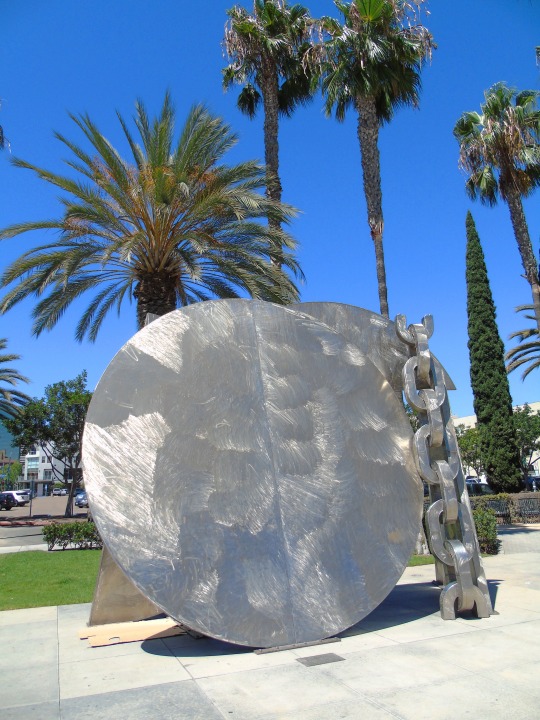

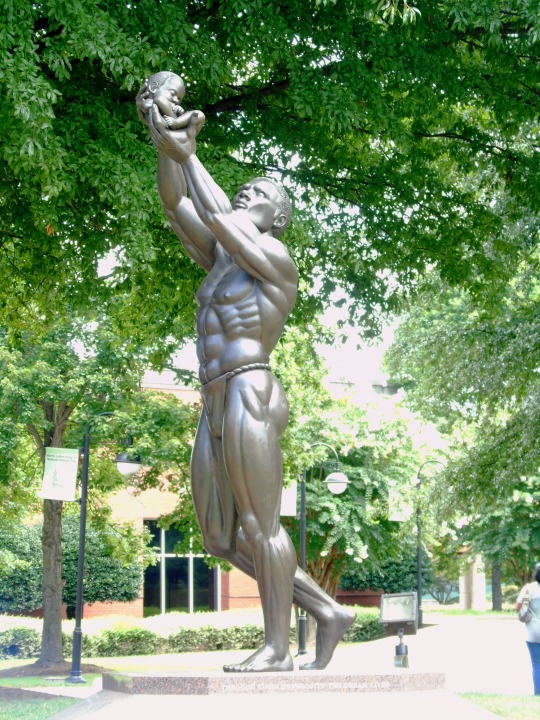
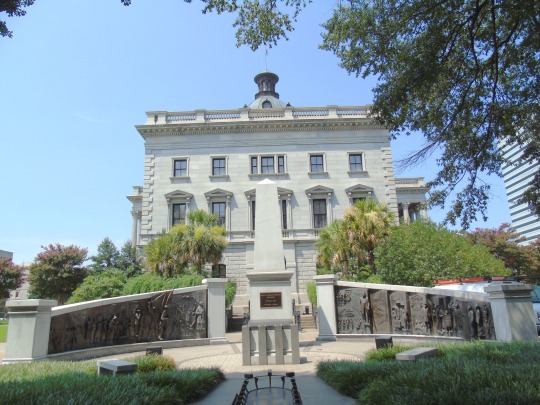
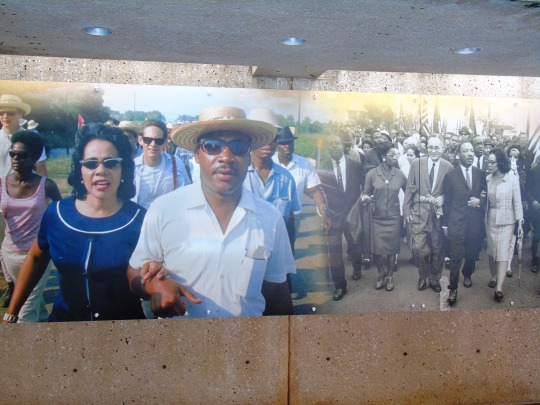

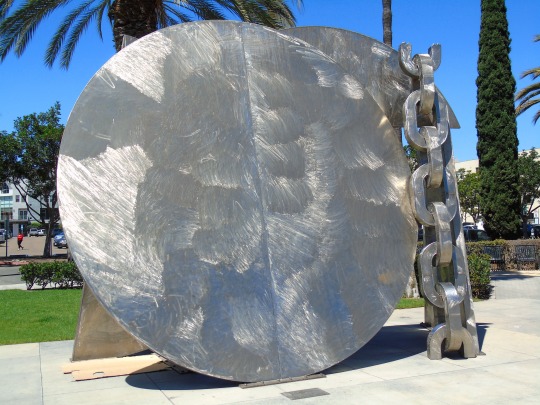
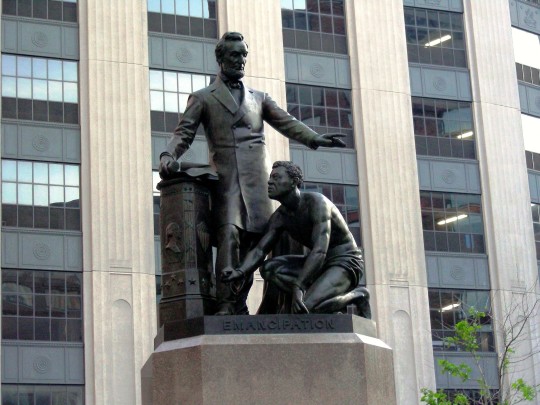
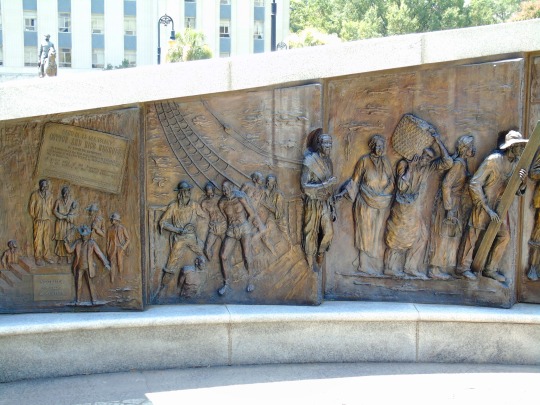

Juneteenth
The freedom of African Americans from slavery in the U.S. in 1865 is celebrated on the holiday Juneteenth on June 19. Juneteenth is made up of the words ‘June’ and ‘nineteenth,’ and it is on this day that Major General Gordon Granger arrived in Texas more than 155 years ago to inform slaves that slavery had been abolished.
The freedom of African Americans from slavery in the U.S. in 1865 is celebrated on the holiday Juneteenth on June 19. Juneteenth is made up of the words ‘June’ and ‘nineteenth,’ and it is on this day that Major General Gordon Granger arrived in Texas more than 155 years ago to inform slaves that slavery had been abolished.
When is Juneteenth 2022?
Juneteenth, which marks the end of slavery in the U.S. and commemorates African-American freedom, is observed on June 19.
History of Juneteenth
According to the official website of the historical event, Juneteenth is ‘the oldest nationally celebrated commemoration of the ending of slavery in the United States.’ Other than marking a pivotal date of significance in American history, Juneteenth also serves as an opportunity for African Americans to cherish their culture and heritage.
More than 155 years old, Juneteenth celebrates the liberation of African Americans from slavery in the U.S. The reason for it being celebrated on June 19 is because, on this day in 1865, when Major General Gordon Granger of the Union Army landed in Texas, he brought the news that the Civil War had ended and all slaves were free.
The proclamation declaring the abolishment of slavery was issued by President Abraham Lincoln on January 1, 1863, in the nation’s third year of an ongoing civil war. Known as the Emancipation Proclamation, it declared that ‘all persons held as slaves within any State or designated part of a State […] shall be then, thenceforward, and forever free.’ Granger’s arrival at Texas was to enforce this decree, which had originally gone into effect two years earlier.
The news had come as a shock to more than 250,000 slaves in Texas who were unaware of it.
On June 19, in the city of Galveston, Granger publicly read General Order No. 3, which stated: ‘The people of Texas are informed that, in accordance with a proclamation from the Executive of the United States, all slaves are free.’
As to why the news of the abolition of slavery reached Texas so late, there are varying accounts. One story states that the messenger bearing the news was assassinated on his journey. Some historians believe that the report on the Emancipation Proclamation was withheld by slave owners in Texas on purpose so that they can go about their business as usual and keep the labor force working. Historians also note that, until 1865, Texas remained a Confederate State, so Lincoln’s proclamation could not have been enforced until Robert E. Lee surrendered to the Union Army and they took over.
Either way, Granger’s arrival with the grand news stirred the air with jubilance and massive celebrations across the state. A former slave named Felix Haywood gave his recount of the first celebration in 1865 in the book “Lone Star Pasts: Memory and History in Texas” — ‘We was all walkin’ on golden clouds […] Everybody went wild […] We was free. Just like that, we was free.’
Juneteenth timeline
June 19, 1865 Texas Slaves Finally Gain Their Freedom
Even though they are officially made aware of the Emancipation Proclamation on this day, many slaves stay with their masters as paid hands.
August 28, 1963 ‘I Have a Dream’
Martin Luther King delivers one of history’s most inspirational speeches in front of roughly 200,000 people at the Lincoln Memorial.
July 2, 1964 President Johnson Signs the Civil Rights Act
This act gives the federal government the power to enforce desegregation while prohibiting discrimination based on race, color, religion, or national origin.
1980 Texas Declares Juneteenth a State Holiday
While Texas was the first state to observe Juneteenth as a state holiday, many others have since followed suit.
June 14, 2019 Call for a National Holiday
“Boston Globe” columnist Renée Graham writes that Juneteenth deserves an elevated status, noting that many African Americans regard the nation’s July 4 holiday with deep ambivalence.
Juneteenth FAQs
Why is Juneteenth called Juneteenth?
Juneteenth is a fusion of the words ‘June’ and ‘nineteenth.’ The emancipation of African Americans from slavery in the U.S. officially happened on June 19.
Is Juneteenth a national holiday?
The only three states yet to legally recognize Juneteenth as either a state or ceremonial holiday are Hawaii, North Dakota, and South Dakota.
What is Juneteenth and why is it important?
Juneteenth is an extremely important holiday in history, commemorating the day when the enslaved people of Texas learned that slavery had been abolished and that they are free.
How to Observe Juneteenth
Fly the Juneteenth flag
Attend a Juneteenth celebration
Watch a movie about slavery
Echoing the red, white, and blue of the U.S. flag, the Juneteenth flag signifies that slaves and their descendants are true Americans. A star in the middle represents Texas, with a larger outer star representing new freedom and a new people.
Some citizens in the southern states celebrate with readings and oral histories of their ancestors, which is an honorable way to remember a somber period in American history. Celebrations also include cookouts, rodeos, concerts, and parades.
Recent titles include "12 Years a Slave," "Glory," Amistad" and "Django Unchained."
5 Courageous Americans Who Fought For Equality
Dr. Martin Luther King, Jr.
Rosa Parks
Mildred Loving
Frederick Douglass
Dred Scott
Perhaps the most widely recognizable name associated with the civil rights movement, Dr. King gave us the famous "I have a Dream" speech in August 1963 — his 1968 murder proved that the movement still had a lot of work to do.
With a simple refusal to surrender her seat on a public bus, Parks made a bold statement for African Americans in the South — her December 1955 arrest inspired the Montgomery Bus Boycott.
Loving and her husband, Richard, were jailed for unlawful cohabitation in Virginia where interracial marriage was illegal in 1958 — their case reached the Supreme Court in 1967, which ruled unanimously in their favor.
An escaped slave, Douglass became an advocate for the abolition of slavery as well as women's rights.
Enslaved African American Dred Scott sued for his family's freedom in 1857 — the Supreme Court ruled against him, finding that no person of African ancestry could claim U.S. citizenship.
Source
#Breaking the Chains by Melvin Edwards#San Diego#Boston#Atlanta#USA#Emancipation Statue by Thomas Ball#Behold by Patrick Morelli#sculpture#Martin Luther King Jr. National Historic Site#original photography#cityscape#Martin Luther King Jr. Center for Nonviolent Social Change#Columbia#African-American History Monument by Ed Dwight#Juneteenth#19 June#tourist attraction#landmark#travel#vacation
1 note
·
View note
Text
A MANIFEST Manifesto
Think, Believe, Act, three words with the power to change systems, visualize and create the future, and enable generations to remember ideals, victories, achievements, and mistakes that should never be repeated. In MANIFEST, desires, goals, and outcomes are brought to reality by thinking, believing, and acting (Michael, 2024). MANIFESTs believe in the law of attraction, where energies and thoughts, regardless of their nature, bring corresponding experiences and circumstances to existence. As a MANIFEST, I believe in the power of visualization, establishing positive affirmations, and setting goals that clearly define my intentions to ensure that my thoughts and actions are aligned with the outcomes I desire are achieved. As a first step towards positive change, impact, or creativity, we should clarify our goals (Michael, 2024). After that, we can visualize success, adopt a positive mindset, and consistently take action toward our aspirations. We can identify the MANIFEST practice in art by examining what the most famous music moguls, sculptors, and artists intended, promoted, and achieved through their creations.
Artists leverage the connection between the human/mind and body/spirit to nurture a desire and goal that leads to tangible results. The foundational thoughts and strategies used to develop their pieces are founded on the understanding that if one chooses to focus on a single thought regarding a specific goal, they can transfer what is in their hearts and minds into the physical environment (Michael, 2024). In art, MANIFESTs integrate the techniques of manifestation with the practical strategies of setting goals to ensure that they can focus their energies and attention on realizing their desires while enhancing their self-efficacy and empowerment. Family ties are emphasized in the film Godfather, but the characters also base their successes and achievements on the MANIFEST principles (Arias, 2018). Vito might have been corrupted by power, but his rise is attributed to his ability to visualize, set goals that reflect his ambitions, and strategically plan how their desires will be realized (Arias, 2018). A similar trait can be noted in Michael Corleone, who evolves from an outsider reluctant to engage in any family business to a ruthless heir because of his inherent ambitions.
MANIFESTs are not just dreamers but individuals who can consistently take steps to realize their desires and goals. They change the negative thought patterns and leverage the subconscious mind to nurture the realities they desire. For instance, The Church at Auvers, 1890, by Vincent Van Gogh, is an artwork that depicts the transformative nature of manifestation. Gogh creates a memory of a life that resonates with the experiences of most individuals through time (Vincentvangogh.org. n.d.). By depicting the church hidden behind its shadow, he conveys a disturbing thought of the dark emptiness of institutions that should provide hope to the less fortunate. It should be recognized that Gogh leveraged his troubled mind to create pieces that established him as an artistic genius (Vincentvangogh.org. n.d.). As a 'mad artist,' his painting, The Church at Auvers, portrays an innovative and unique style that set the stage for the development of many artists who followed him.
MANIFESTs attract the outcomes they envision by leveraging the power of their emotions and thoughts. As portrayed in 'Emancipation Memorial" by Thomas Ball, Abraham Lincoln stands beside a formerly enslaved person kneeling and with broken chains (Hassler, 2024). The sculpture conveys the power of manifestation because the broken chains represent the potential of all individuals in captivity to achieve freedom and equality through vision, desire, and determined actions. Lincoln envisioned a nation where all individuals live free. He would consequently act by signing the Emancipation Proclamation despite the vast opposition from the southern states (Hassler, 2024). Through the MANIFEST principle, creating change that could only be envisioned is possible.
MANIFESTs leverage the connection between human/mind and body/spirit to bring desires into reality. As depicted through art, everything can be attained by envisioning moments, believing, setting goals, and diligently working toward them. While all individuals dream and have desires, most differ from MANIFESTs because they manifest negatively or overcomplicate their intentions. Our potential to manifest in art is boosted because the work involves deep meditation and creativity (Michael, 2024). Artists exemplify the MANIFEST principle because they leverage their work to place themselves in a position of creative flow. Developing the pieces demands deep and intense focus for long periods and a consistent direction of focus toward what is visualized (Michael, 2024). Through their pieces, artists transform their visions into something physical that amplifies what they envisioned. They portray their desires and how they want them to look like.
By clearly defining what is desired, MANIFESTs enhance their understanding of what they want and why. Goals ensure that the vision is imagined as a vivid memory. In art, MANIFESTs gain insight into the medium and technique once they set their goals. Rather than worrying about the quality of the artwork, they emotionally connect with them and their visual image. Artists also demonstrate consistency in their practice and actions to ensure that each component is delivered as envisioned. As a personal journey, becoming a MANIFEST means that an individual is free to select the strategies and techniques that resonate with them. As such, MANIFESTs must believe in what they envisioned, act as if their visions have been realized, leverage their emotions to embrace the vision, practice gratitude even before fruition, and consistently work towards the set goals.
References
Arias, D. (2018). Cinematography – The Godfather: Anatomy of a Film. UC Berkeley. https://theseventies.berkeley.edu/godfather/tag/cinematography/
Hassler, C. (2024). Emancipation Memorial (U.S. et al.). Www.nps.gov. https://www.nps.gov/places/000/emancipation-memorial.htm
Michael, E. (2024, September 26). The Science Of Manifestation: The Power Of Positive Thinking - MentalHealth.com. MentalHealth.com. https://www.mentalhealth.com/tools/science-of-manifestation
Vincentvangogh.org. (n.d.). The Church at Auvers, 1890 by Vincent Van Gogh. Www.vincentvangogh.org. https://www.vincentvangogh.org/the-church-at-auvers.jsp
0 notes
Text

River Eye
Limited Edition 12" Vinyl
Released October 31, 2024
Artsy Records 2024 ART-40
All music by Piia Rinne Mastered by Samuli Tanner Visual concept by Miia Rinne Layout by Tom Backström Bleeding heart by Eija Koponen
Making of this album was supported by the Arts Promotion Centre Finland
Piia Rinne, a Pori-based sound artist and textile designer, operates at the intersection of sonic experimentation and tactile craftsmanship, weaving a profound connection between these two mediums. Her debut vinyl, River Eye, released under Artsy Records, presents an evocative foray into experimental music, one that defies traditional genre classifications. Artsy, known for its dedication to "the trve experimental music heads," provides a fitting platform for Rinne's boundary-pushing auditory visions.
The album, River Eye, is a radical exploration of sound, largely constructed from tape loops, rough cut-and-paste digital editing, and pitch shifting. These techniques evoke a tangible, almost sculptural relationship to sound, where the process of creation becomes an aesthetic and philosophical gesture. The raw, analog feel of the work resonates with a certain materiality—sound as fabric, woven through repetitions and mutations, distorting and elongating time. Her process becomes a metaphor for the textile artist’s craft: cutting, stitching, and layering materials, Rinne shapes sound in much the same way she might approach fabric, imbuing each element with texture and depth.
River Eye is, in many ways, psychedelic, but it eludes the trappings of the familiar, often commodified tropes of "psychedelia." Instead, Rinne’s sound world confronts the listener with an intense, emancipatory psychism, one that refracts consciousness in ways that question the limits of perception, technology, and embodiment. Through her rough, fragmented editing techniques, she presents a fractured auditory reality, one that mirrors the discontinuities of lived experience. Her pitch-shifting manipulations dislodge sounds from their referential anchors, further unsettling the listener’s expectations. In this way, River Eye pushes against the normative frameworks that constrain both art and life, carving out a space of radical freedom.
Piia Rinne’s River Eye is not just music, nor is it just art—it is a deeply philosophical engagement with sound as a medium of resistance. The album serves as both a listening experience and an intellectual provocation, urging us to reconsider the ways in which we hear the drum of cosmos, experience time and relate to the materiality of the world. In Rinne’s hands, sound becomes a tool for emancipation, a way of unraveling the oppressive structures that govern both art and life and weaving together new possibilities for the future.
- Juho Toivonen
1 note
·
View note
Text
Butterfly Juneteenth: A Symbol of Hope and Resilience in Fashion
Juneteenth, a celebration of freedom and African American culture, finds a poignant symbol in the butterfly. This pairing of Juneteenth and the butterfly creates a powerful metaphor for transformation, resilience, and hope.

Buy now:19.95$
The butterfly's journey from caterpillar to chrysalis to winged beauty parallels the African American experience of moving from bondage to emancipation. Just as a butterfly emerges from its cocoon, Juneteenth commemorates the emergence of a people from the constraints of slavery into the light of freedom.
In Juneteenth celebrations, butterfly imagery might be incorporated into decorations, artwork, or even as a theme for community events. The vibrant colors of butterflies can reflect the joy and vitality of the holiday, while their delicate nature reminds us of the fragility and preciousness of freedom.
Butterflies also symbolize endurance and adaptability, qualities deeply ingrained in African American history and culture. Their ability to migrate vast distances resonates with the journeys many African Americans undertook in search of liberty and opportunity.

Buy now
Moreover, like butterflies pollinating flowers and contributing to the ecosystem, Juneteenth celebrates the numerous contributions African Americans have made to society, culture, and the nation as a whole. The butterfly in the context of Juneteenth thus becomes a multifaceted symbol of liberation, transformation, and the ongoing journey toward equality and justice.
African Pride Afro Black Women embody strength, beauty, and resilience. These women celebrate their heritage and natural features, particularly their iconic afro hairstyles, which have become powerful symbols of cultural identity and self-love.
Their pride is rooted in a rich history of overcoming adversity and challenging beauty standards that often excluded them. By embracing their natural hair texture and African features, they make a bold statement about self-acceptance and cultural affirmation.

Buy now
These women are diverse, representing various shades, sizes, and backgrounds within the African diaspora. They are leaders, innovators, artists, and changemakers who continue to break barriers and inspire future generations.
African Pride Afro Black Women are not just defining beauty on their own terms; they're reshaping societal norms, advocating for representation, and fostering a sense of community and empowerment among Black women worldwide.
Butterfly remembrance gifts offer a gentle way to honor departed loved ones. These thoughtful items often feature delicate butterfly motifs symbolizing transformation and hope. From personalized jewelry to garden sculptures, these gifts provide comfort to those grieving. They serve as beautiful reminders of cherished memories

Buy now
and the enduring nature of love. Butterfly-themed candle holders, wind chimes, or memorial stones can create peaceful spaces for reflection. These gifts embody the idea that, like a butterfly's metamorphosis, our loved ones have transformed but live on in our hearts.
#Butterfly Memorial Gifts#Remembrance Gifts#Sympathy Gifts#Loss Gifts#African Pride Afro#Black Women Haircare#Natural Hair Care#Afro Hair Products#Butterfly Juneteenth#Juneteenth Butterfly#Black History Month#Freedom Butterfly#View all AUTISM GIFTS products: https://zizzlez.com/trending-topics/hobbies/autism-spectrum-awareness-month/#All products of the store: https://zizzlez.com/
1 note
·
View note